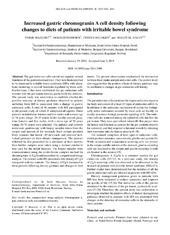| dc.contributor.author | Mazzawi, Tarek | en_US |
| dc.contributor.author | Gundersen, Doris | en_US |
| dc.contributor.author | Hausken, Trygve | en_US |
| dc.contributor.author | El-Salhy, Magdy | en_US |
| dc.date.accessioned | 2015-03-20T07:31:40Z | |
| dc.date.available | 2015-03-20T07:31:40Z | |
| dc.date.issued | 2014-11 | eng |
| dc.identifier.issn | 1791-2997 | |
| dc.identifier.uri | https://hdl.handle.net/1956/9596 | |
| dc.description.abstract | The gut endocrine cells control and regulate several functions of the gastrointestinal tract. They have been reported to be abnormal in irritable bowel syndrome (IBS), with alterations occurring in several functions regulated by these cells. Furthermore, it has been established that gut endocrine cells interact with the gut lumen contents, particularly the nutrients. The present study was undertaken to establish whether the positive outcome of dietary guidance observed in patients suffering from IBS is associated with a change in gastric endocrine cells. A total of 46 patients with IBS participated in the present study, of which 14 completed all aspects. These patients included nine females and five males with a mean age of 34 years (range, 20‑45 years). In the healthy control group, nine females and five males, with a mean age of 54 years (range 26‑70 years) were selected. The patients and controls underwent gastroscopy with biopsy samples taken from the corpus and antrum of the stomach. Each patient attended three sessions that lasted ~45 min each, and received individual guidance on their dietary management. The patients followed the diet prescribed for a minimum of three months, then further samples were taken using a method similar to that used for the initial biopsies. The biopsy samples were immunostained using the avidin‑biotin complex method for chromogranin A (CgA) and quantified by computerized image analysis. The patients with IBS presented a low density of CgA compared with the controls. The density of CgA increased in these patients following dietary guidance and changes in food intake. The present observations emphasized the interaction between food intake and gut endocrine cells. The current study also suggests that the positive effects of dietary guidance may be attributed to changes in gut endocrine cell density. | en_US |
| dc.language.iso | eng | eng |
| dc.publisher | Spandidos | eng |
| dc.relation.ispartof | <a href="http://hdl.handle.net/1956/10371" target="blank">The Role of Diet in Irritable Bowel Syndrome with special reference to Gut Neuroendocrine System</a> | |
| dc.rights | Attribution CC BY | eng |
| dc.rights.uri | http://creativecommons.org/licenses/by/4.0 | eng |
| dc.subject | Diet | eng |
| dc.subject | computerized image analysis | eng |
| dc.subject | Chromogranin A | eng |
| dc.subject | guts endocrine cells | eng |
| dc.subject | Immunohistochemistry | eng |
| dc.title | Increased gastric chromogranin A cell density following changes to diets of patients with irritable bowel syndrome | en_US |
| dc.type | Peer reviewed | |
| dc.type | Journal article | |
| dc.description.version | publishedVersion | en_US |
| dc.rights.holder | Copyright 2014 Mazzawi et al | |
| dc.identifier.doi | https://doi.org/10.3892/mmr.2014.2498 | |
| dc.identifier.cristin | 1171853 | |
| dc.source.journal | Molecular Medicine Reports | |
| dc.source.40 | 10 | |
| dc.source.14 | 5 | |
| dc.source.pagenumber | 2322-2326 | |

